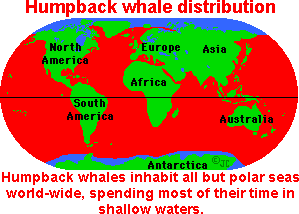
ANIMAL WORLD
Megaptera novaeangliae
( Humpback whale)
Biogeography:
Humpback whales, Megaptera novaeangliae, live in polar and tropical waters, particularly those of the Atlantic, Arctic, and Pacific Oceans. Their range also includes the waters of the Bering Sea and the waters surrounding Antarctica.Biogeographic Regionsarctic ocean native atlantic ocean native pacific ocean native
Evolution:
All members of the order cetacea are believed to have evolved from terrestrial hoofed mammals like cows, camels and sheep some 45 million years ago - that's about 40 million years before man! Throughout their evolution, cetaceans have become perfectly suited to an aquatic environment, and are virtually incapable of leaving it. Cetaceans illustrate an example of adaptive radiation among mammals. Adaptive radiation allows mammals as a group to effectively inhabit the land, the sea, and the air through the development of special adaptations needed to survive in each of these environments.
Kingdom: Animalia (animals)
Phylum: Chordata (vertebrates)
Class: Mammalia (mammals)
Order: Cetacea (whales and dolphins)
Suborder: Mysticeti (baleen whales)
Family: Balaenopteridae
Genus: Megaptera
Species: novaeangliae




Behavior:
-
Humpbacks travel in large, loose groups. Most associations between humpbacks are temporary, lasting at most a few days. The exception is the strong and lasting bond between mother and calves.
-
Humpbacks are very acrobatic, often breaching high out of the water and then slapping the water as they come back down. Sometimes they twirl around while breaching. Breaching may be purely for play or may be used to loosen skin parasites or have some social meaning.
-
Humpback whales are the noisiest and most imaginative whales when it comes to songs. They have long, varied, complex, eerie, and beautiful songs that include recognizable sequences of squeaks, grunts, and other sounds.
-
Humpback whales live in groups. They migrate seasonally from the tropics to the northern feeding grounds. In the tropics, they are found in dense aggregations on shallow banks.
Status:
The humpback whale is classified as Least Concern (LC) on the IUCN Red List (1).
Isolation mechanisms:
During the summer months in both the Northern and Southern Hemisphere, the humpback whales are gorging themselves with food. The high latitudes provide an endless supply of food during the summer, but in the winter, humpbacks migrate to lower latitudes and warmer water. Geography isolations occurs between other whales because the location of the migration season is diferent between species, that type of isolation mechanism is called, geographic isolation.
